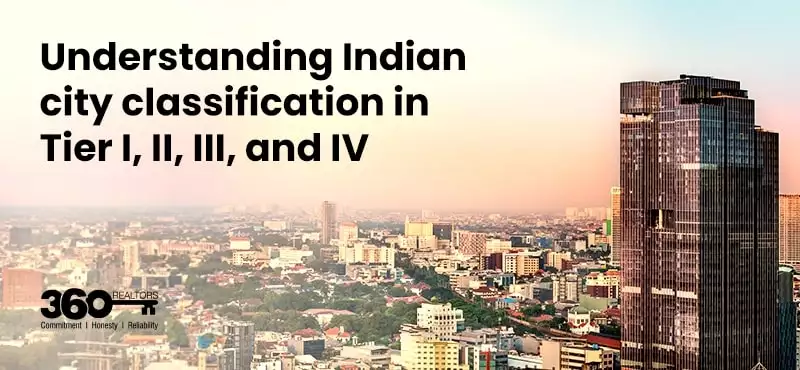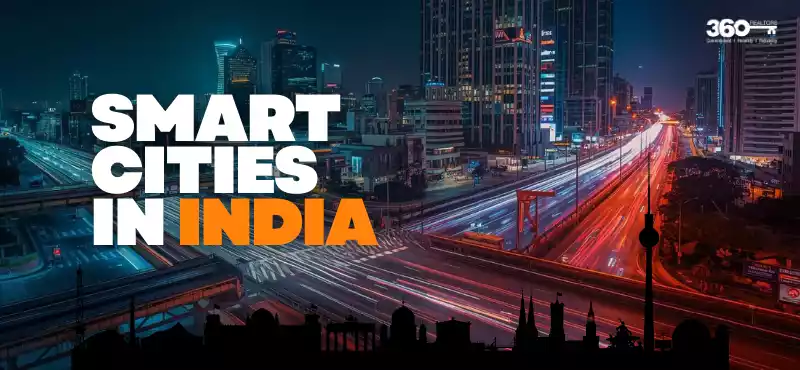In India, the Central Government has categorized the cities into different tires. While purchasing a home, you would be looking forward to buying a property in one of these cities. It is important to understand what these tires mean for buyers, as they demonstrate various factors like size of population, growth of infrastructure, living standards, and economic enhancements. In this guide, you will get to know what tier 1 cities in India are. We have also discussed tires 2,3, and 4 for your convenience.
When it comes to classification, there are two ways of dividing the cities. While they have been categorized on the basis of business activity and population under one mechanism, the other approach involves dividing the cities based on rural, semi-urban, or urban demographics. Take a close look at what these tiers mean.
According to the classification made by the RBI, cities with a population exceeding 1 lakh come under tier 1 cities in India. The real estate market in these cities is well-developed. Besides, families residing in these cities enjoy better social and civic amenities. Business infrastructures in tier 1 cities are well-developed. This explains why the property markets in tier 1 cities are expensive. In India, the leading tier 1 cities are Delhi, Bangalore, Chennai, Kolkata, Hyderabad, Mumbai, Pune, and Ahmedabad.
Tier 2 cities in India are those with a developing or fast-growing real estate market. The investments and infrastructure in these cities are increasing steadily, although they are yet to hit their peak levels. In tier 2 cities, property prices usually soar as these markets enjoy sustained development. Compared to tier 1 cities, these property markets are relatively cheaper. According to the classification made by the RBI, tier 2 cities have a population ranging between 50,000 to 99,999.
In India, there are 97 tier 2 cities, including Bhopal, Amritsar, Jaipur, Kochi, Patna, Lucknow, Agra, Kanpur, and Srinagar.
The tier 3 cities in India are those with a population between 20,000 and 49,999. In these cities, the real estate markets are marginally developed or non-existent. Along with this, business and infrastructure growth in these cities is limited. For future growth, these cities need more infrastructure and investments.
Some of the tier 3 cities in India are Hosur, Junagarh, Udaipur, Salem, Meerut, Bikaner, Cuttack, Mathura, and Nasik.
In tier 4 cities in India, the population ranges from 10,000 to 19,999. These are actually small towns, where there’s a lot of room for infrastructure development and investments. The real estate sector looks in poor shape, and business activities are negligible in these places.
Some of the tier 4 cities in India are Kalyani, Bhadreswar, Naada, and Datia.
Also Read | Top 10 Best Cities to Live in India
Now, have a look at the population of the largest cities in India. The tier classification has been made based on this population.
|
City
|
Population
|
|
Mumbai
|
1,24,42,373
|
|
Delhi
|
1,10,07,835
|
|
Bangalore
|
84,25,970
|
|
Hyderabad
|
68,09,970
|
|
Ahmedabad
|
55,70,585
|
|
Chennai
|
46,81,087
|
|
Kolkata
|
44,86,679
|
|
Surat
|
44,67,797
|
|
Pune
|
31,15,431
|
|
Jaipur
|
30,46,163
|
|
Lucknow
|
28,15,601
|
|
Kanpur
|
27,67,031
|
|
Nagpur
|
24,05,665
|
|
Indore
|
19,60,631
|
|
Thane
|
18,18,872
|
|
Bhopal
|
17,95,648
|
|
Visakhapatnam
|
17,30,320
|
|
Pimpri-Chinchwad
|
17,27,692
|
|
Patna
|
16,84,222
|
|
Vadodara
|
16,70,806
|
|
Ghaziabad
|
16,48,643
|
|
Ludhiana
|
16,18,879
|
|
Agra
|
15,85,704
|
|
Nashik
|
14,86,053
|
|
Faridabad
|
14,14,050
|
|
Meerut
|
13,05,429
|
|
Rajkot
|
12,86,678
|
|
Kalyan-Dombivli
|
12,47,327
|
|
Vasai-Virar
|
12,22,390
|
|
Varanasi
|
12,01,815
|
|
Srinagar
|
11,80,570
|
|
Aurangabad
|
11,75,116
|
|
Dhanbad
|
11,62,472
|
|
Amritsar
|
11,32,383
|
|
Navi Mumbai
|
11,20,547
|
|
Allahabad
|
11,12,544
|
|
Howrah
|
10,77,075
|
|
Ranchi
|
10,73,427
|
|
Gwalior
|
10,69,276
|
|
Jabalpur
|
10,55,525
|
|
Coimbatore
|
10,50,721
|
|
Vijayawada
|
10,34,358
|
|
Jodhpur
|
10,33,918
|
|
Madurai
|
10,17,865
|
|
Raipur
|
10,10,087
|
|
Kota
|
10,01,694
|
|
Chandigarh
|
9,60,787
|
|
Guwahati
|
9,57,352
|
|
Solapur
|
9,51,558
|
|
Hubli-Dharwad
|
9,43,788
|
|
City
|
GDP
|
|
Mumbai
|
$ 368 billion
|
|
Delhi
|
$ 293 billion
|
|
Bangalore
|
$ 110 billion
|
|
Hyderabad
|
$ 74 billion
|
|
Chennai
|
$ 66 billion
|
|
Kolkata
|
$ 63 billion
|
|
Pune
|
$ 48 billion
|
|
Ahmedabad
|
$ 47 billion
|
|
Surat
|
$ 40 billion
|
|
Visakhapatnam
|
$ 26 billion
|
The classification of cities in India is also based on income tax. A higher number of taxpayers in a city indicates better economic infrastructure. In these cities, employment opportunities and growth look impressive. Here are some of the cities from tier 1 and 2 categories that hold the record of the maximum number of taxpayers. This leads to further economic growth of the country.
|
City
|
Tax Collected in FY 2022-23
|
|
Mumbai
|
Rs 4.95 trillion
|
|
Delhi
|
Rs 2.07 trillion
|
|
Bangalore
|
Rs 2.04 trillion
|
|
Chennai
|
Rs 1.05 trillion
|
|
Hyderabad
|
Rs 88,438 crore
|
|
Kolkata
|
Rs 56,422 crore
|
|
Ahmedabad
|
Rs 41,000 crore
|
|
Gurgaon
|
Rs 40,000 crore
|
Also Read | List of Top 10 Smart Cities in India
Population of India Based on States
When you classify tier 1 cities in India or tier 2 cities in India, it’s imperative to take a note of the population. While metro cities have a population above 1 lakh, urban areas have the population ranging between 1 lakh to 10 lakhs. In semi-urban areas, the population is anything between 10,000 to 1 lakh. On the other hand, rural areas are sparsely populated, and have a count less than 10,000.
The government of India has classified its cities into different tiers based on different factors. These include the quality of lifestyle, population, education, and infrastructure. Based on the tier, other essential aspects like taxation along with economic and social progress are determined.
An Overview of Real Estate Development in Tier 1 Cities in India
Industry reports reveal that in 2022, sales of residential property in tier 1 cities in India were higher than those in second tier cities by 250%. This spike in sales took place due to a number of factors. The confidence of consumers has increased in hard assets after the market volatility amidst the pandemic. Besides, the RBI had lowered the REPO rate in the first half of 2022. Along with this, the lower cost of credit and a boost in liquidity in finances led to the boost in sales.
An Overview of Real Estate Development in Tier 2 cities in India
Compared to mega cities, the cost of living in tier 2 cities in India are comparatively lower. Besides, people living in these cities enjoy a better work-life balance. Property cost in these cities remains affordable, although they witness a consistent growth in infrastructure. Tier 2 cities with a high potential are already attracting real estate developers and the government. For example, the government of Goa is coordinating with STPI (Software Technology Parks of India) to push digital entrepreneurship and support software experts. According to market research, these cities will become major growth hubs for the economy of the country and the real estate sector in the coming years.
An Overview of Real Estate Development in Tier 3 cities in India
Tier 3 cities in India have lots of room for development. The real estate industry in these cities is yet to pick up pace. In terms of prices of property, tier 3 cities show a striking difference when compared to tier 1 cities. Since these cities have a low level of development, the property prices in tier 3 cities in India are lower. As a result, the prices of assets decrease, particularly when it comes to construction materials and land. A substantial development is currently going on in many of these cities. For investors, these places present a good opportunity for investment. Both residential and commercial projects in tier 3 cities cost lower than the ones in tier 1 cities in India.
An Overview of Real Estate Development in Tier 4 cities in India
The tier four cities in India are villages or small towns. These towns aren’t developed and need lots of funding for infrastructure growth. Thanks to the ambitious project of the government called “Housing for All”, the demand for affordable property has picked up pace in these cities. This has led to a significant shift of the key players to the low-income housing segment from the traditional segment. Many players have also moved out of the metro cities that are already saturated, and they are gradually becoming inclined towards these tier 4 cities. Besides, they are moving to satellite towns as these areas continue to witness a surge in population.
In India, cities are classified into tiers due to several reasons. These include:
• Administrative Efficiency: Due to this classification of cities, governments can manage and govern the places with greater efficiency. This structure provides a robust framework to implement policies and allocate necessary resources to make better decisions.
• Evaluating the Economy: The classification of cities into tires goes a long way in helping the government evaluate the economic strength and potential of the area. As a result, investors and businesses can gain transparency about how attractive the markets are, and how good the growth opportunities look.
• Infrastructure and Urban Planning: Classifying cities into different tiers helps in infrastructure development through urban planning . The government can identify the current development needs of these places and allocate resources accordingly. They can also prioritize projects and pay attention to the areas that need more development.
• Inspection for Investment: Dividing the cities in India into different tiers go a long way in helping businesses and investors. They can identify promising markets based on the customer base and business environment depending on the purchasing capability of the city.
• Evaluating the Quality of Lifestyle: One of the key reasons to classify cities in India into different tiers is the fact they help in assessing the quality of lifestyle. This enables policymakers and researchers round upon areas that need improvement. Accordingly, they make informed decisions regarding the allocation of resources.
Several factors are taken into consideration while classifying cities in India based on their tiers. These include:
• Size of Population: The population of a city plays a crucial role in identifying the category under classification. This population is the highest in tier 1 cities. Next comes the tier 2, 3, and 4 cities in their respective orders.
• Development of Economy: The government factors in several economic factors while classifying cities in India based on different tires. These include employment opportunities, GDP, and per capita income. These are some of the most important parameters while evaluating tiers. The cities coming under higher tires manifest better economic performance. They present businesses with a better environment to be carried out.
• Infrastructure Growth: The infrastructure in a city largely determines the quality of lifestyle individuals can enjoy while purchasing a property there. For instance, families of working professionals prefer tier 1 cities as they get access to a strong network for transportation, wide roads, advanced airports, and seamless communication. With the tier level going down, the development in infrastructure turns out to be less profound.
• Education and Healthcare Facilities: Healthcare and educational infrastructure need to be considered when cities are classified. In tier 1 cities in India, you will generally come across the most esteemed universities and hospitals in the country. The quality of lifestyle largely depends on these facilities that are available to the residents in the cities.
• Importance of Administration: The classification of cities in India into tiers is based on the importance of administration. In cities where the administrative power is greater, the tier placement is higher.
The classification of cities into tiers in India has several future implications. These include economic possibilities in these areas, regional development, infrastructure, and trends of employment. Have a look at the future implications of classifying cities into different tiers.
• Balanced Development - From time to time, policymakers come up with different strategies based on the tier classification. These promote a balanced growth and development in cities. They can make informed decisions while allocating resources and invest accordingly. This helps in the balanced development of an area, thereby minimizing inconsistencies.
• Economic Prospects - The tier 1 cities in India attract investments as they present an extensive range of work opportunities. The government can also control economic instabilities by making the most of the potential in tier 2 cities in India. This ensures a balanced and controlled growth of the country.
• Growth of Infrastructure - When cities are classified into tiers, the government can plan infrastructure better. In tier 1 cities, infrastructure upgrades are more intense, as these cities witness a rapid expansion with higher population and civic pressure. The development of infrastructure enhances the standard of living for the families in these cities, besides attracting investments. This explains why the government largely focuses on infrastructure growth in tier 2 cities in India and tier 3 cities in India
• Migration and Employment - In tier 1 cities in India, the rate of migration is usually higher. This weakens the existing infrastructure significantly. When the government develops smaller cities, they generate further employment opportunities. A balanced approach in this regard minimizes pressure on urban centres.
• Future Prospects - From time to time, the government needs to review the classification of cities and update the tires, considering new development and emerging urban areas. When they leverage the strength of each tier, they can trigger a growth of the economy. This nurtures sustainability and leads to the development of specialized cities.
Over the last few years, the government of India has taken several initiatives to drive urban development in different cities. For instance, it has launched the smart cities mission, under which as many as 100 cities under the second and third tiers are being developed. The objective is to create citizen-friendly and urban living environments.
Also, the AMRUT scheme is currently in place. It has been designed to provide basic infrastructure to residents like water supply, urban transport, sanitization, and green spaces. This mission is being carried out in the tier 2, 3, and 4 cities.
Other schemes include the Pradhan Mantri Awas Yojana (PMAY) to provide affordable housing facilities with subsidies and financial assistance for construction. On the other hand, the Swachh Bharat Mission aims to gain sanitization and cleanliness in urban areas. The government is actively carrying out waste management to promote hygiene.
FAQs
Tier 1 cities are the ones with the highest populations. Real estate prices in these cities are high, and they witness extensive business activities. Tier 2 cities fare a notch lower on these parameters.
The main industries in tier 1 cities in India are manufacturing, IT, finance, and services. Among the tier 1 cities in India, Mumbai leads from the front. Next comes Bengaluru with a well-developed IT infrastructure.
In tier 1 cities, transportation facilities are well-developed. Different modes of transportation are available in these cities. These include metro railway, buses, taxis, and auto-rickshaws. In Mumbai, there is a suburban railway system, while Delhi and Kolkata have their metro railway networks.Â
Tier 3 cities in India are the ones with their population ranging between 20,000 and 49,999.






